1. Problems of historical and archaeological research of the waterways and shipbuilding in North-western RussiaThe investigations of the waterways, which were based on the interpretation of written sources, started in the 19th century. Taking as a basis the chronicles and landscape-archaeological investigations, Z. D. Hodakovsky in the article "Means of communication in ancient Russia" (1837) gave a detailed description of the north-western waterways: by the Velikaya River to the Pskovskoye and the Chudskoe lakes and to the Narva River; by the Luga; by the Volkhov, the Ladoga Lake to the Neva River (Fig. 1). The place of these ways in the system of the ancient Russian communications is considered in the fundamental book by N. P. Zagoskin "The waterways and shipbuilding of pre-Peter Russia", which was published in 1910. Since the 19th century, the problems of the organisation of the waterways service and control-system are discussed in the historiography. During the investigation of the documents of Novgorodian-Hanseatic league trade, M. Berezlikov concluded that the combined cargo transportations had existed on the Volkhov-Ladoga-Neva waterway: the separate parts of this way were to be passed by different types of vessels. Taking as a basis the Scandinavian sagas and archaeological finds from Staraya Ladoga, E. A. Rydzevskaya supposed this system had been formed in the Viking epoch. Fig 1: 1 - Staraya Ladoga, 2 - Ryukikovo gorodishe, 3 - Novgorod, 4 - Pskov, 5 - Oreshek, 6 - Yamgorod, 7 - Ivangorod, 8 - Narva On the next stage started in the middle of our century, the archaeological and numismatic sources are often used for the solution of the problems of the waterways’ exploitation. The mapping, dating and systematisation of the sources in the works of E. N. Nosov, A. N. Kirpichnikov, and G. S. Lebedev allowed to make the partial reconstruction of the process of forming and functioning of the waterways. The modelling of the communication on the medieval waterways became the perspective trend in the modern science. It includes different types of vessels, even copies or reconstructions of the medieval crafts. By this modelling, we can determine the speed of the motion on the separate parts of the way, and also better understand the intercommunication between the arrangement of the archaeological sites and the ancient system of navigation. The investigations of the problems of the origin and development of ancient Russian shipbuilding started in Russian historiography of the 19th century by the works of the famous historians: N. M. Karanisin, E. A. Pogodin, and S. Gedeonov. The consideration of these problems was based on the interpreting of the written sources and of the etymological analysis of the ship’s terminology. The main results of that research period, reflected in the books of N. P. Zagoskin and V, V. Mavrodin, were the singling out from the vessel names mentioned in documents, their general terms: e.g. lodya, corabl, shneka, and busa, which marked any crafts or one of their categories – e.g. ship; the dividing of the concrete types of vessels into two groups: the Russian crafts cheln, strug, nasad, uchan, ushkuj, marine and naboinaya lodya; the foreign crafts – loiva, galea, and skedia. The evolutionary theory of the crafts' development: from the simple types to more complicated was worked out in this period. According to it the oldest crafts were made from rind, then the logboat and boat with dugout base appeared, and at last the plank boat and ship were invented. The new stage in the process of research, connected with the scientific introduction of the new archaeological sources on shipbuilding started in the middle of our century. The crafts' details were originally singled out from the Novgorodian finds by A. V. Artsikhovsky, and then at Staraya Ladoga by G. P. Grozdilov. The classification of the crafts' details from the archaeological finds was made in 1954 by P. Zagoskin by S. N. Orlov in the work "The wooden artefacts of the 7th - 10th centuries from Staraya Ladoga". He distinguished several types of vessels: cheins, small boats, flat-bottomed vessels of the middle and large sizes. The systematisation of the crafts' details from the Nerevsky excavation trench at Novgorod was executed by B. A. Kolchin in the book "Wooden artefacts of the medieval Novgorod", in which he divided all wooden craft's details into two parts, according to their size: "korabelnije" (ship’s) and "lodochnije" (boat's) details. Today considerable archaeological material has been accumulated Thus the attempts to reconstruct actual craft types, mentioned in the written sources have already been made. These are S N. Orlov's korabl (Fig. 5.2), M. H. Aleshicovsky's naboynaya lodiya (Fig. 1, 10.6) and B. A. Kolchinys korabl of the 12 - 13 centuries, associated by him with such types as ushkui, uchan or strug (Fig. 6.2). The main part of these reconstructions was based on the fragmentary finds without reliable analogues. However the archaeological finds gave a possibility to broaden our notion about crafts, which had been used in the Middle Ages in north-western Russia. 2. Main waterways of the ancient Russian North-WestThe Volkhov - Ladoga - Neva waterway (Fig. 2), according to the condition of ancient navigation is divided into three main parts: two river and one lake part. The topographical arrangement of the archaeological sites on the shores of this waterway shows only the small rise of Volkhov’s water-level during the Middle Ages. Fig 2: Volkhov - Ladoga - Neva waterway The several periods in the exploitation of that waterway can be distinguished, according to the archaeological and written sources. A so-called "archaic" period can be dated to the early Iron Age. At that period only local communications existed along the Volkhov within the area of the archaeological cultures of that time. The sites of these cultures were discovered in the key-points of the river. The Russian-Viking period continued from the middle of 8th to the end of 11th centuries. The archaeological sites of that time are concentrated in three zones of the waterway: this is, first of all, two large conglomerations of settlements in the Upper and Lower Volkhov, which were already formed in the 8th - 10th centuries, and next, the zone near the Neva-river mouth, where many hoards of coins were found – it shows the existence of the trading sites in that area. At that period the Volkhov - Ladoga - Neva waterway was the most important part of the transcontinental trade way from north Europe to the Arabian East and to Byzantium. The systems of organisation of navigation and control were formed at all its length. Vikings, the inhabitants of Staraya Ladoga, did this work at the west part of the way (from the Neva mouth to the Lower Volkhov) and on Volkhov the local population did the same work. At the first part of the way merchants sailed on the Scandinavian sea-ships, then at the second part small keel-crafts and flat-bottomed ferry boats were used. During the next Novgorodian-Hanseatic league period (from 12th to the beginning of 14th centuries) the Volkhov-Ladoga-Neva waterway gradually passed to the direct control of Novgorod. The lzhora tribe, being dependent from Novgorod, guarded the Neva part of the way. On the next stages, in the case of the enemy's penetration to the Ladoga Lake, the guard functions passed to the inhabitants of Staraya Ladoga and Novgorod. The active development of Novgorodian navigation on the Baltic Sea and trade with Gotland and the Hanseatic league is connected with the beginning of this period (the 12th century). The part of the waterway by the Ladoga and the Neva passed to the service's zone of Russian boatmen and pilots. The Novgorodian period continued from the beginning of the 14th to the end of the 15th centuries. The foundation of Oreshek (1323), the demarcation of the Novgorodian and Swedish possessions (1324) and the colonisation of the Neva shores by Russian population allowed Novgorod to strengthen the system of control in the west part of the way and to turn Neva region into the fleet base. It gave to Russian craft-owners the possibility to service the parts of the trade ways, and in the war periods to carry out the navy operations in the Finnish Gulf. The comparison of the written sources data and the results of experiment shows that around five days were needed to sail with a fair good wind from middle Sweden to the Neva mouth. The travel to Staraya Ladoga took up 8-12 days, and to Novgorod the vessel could sail during 13-17 days. The voyage back from Novgorod to middle Sweden took up about 10-11 days with a fair good wind and voyage from Staraya Ladoga could last for a week. The main sea-way went from the Neva mouth along the south coast of the Finnish Gulf to the north-western Estonia, then across the gulf to the Cape Porkalla in Finland and then through the Åland Isles to middle Sweden. The analysis of the documents and facts, received during the experiment, shows the considerable variations in the speed of crafts, which depended on navigation and weather conditions. Thus the strict stages of the communication by that waterway cannot be distinguished. Probably the vessels made the constant stops only in key-points, where the conditions of travelling changed, and in large centres. The way by the Velikaya River to the Pskovskoye and the Chudskoye lakes and to the Narva River (Fig. 3) had not been changed to a great extent from the Middle Ages, except the displacement of Teploye lake coastline, in the middle part of the way. But that event didn't influence on the conditions of navigation. Fig 3: Pskovskoye - Chudskoye - Narva waterway The several stages of the navigation by this way can be distinguished after the research of the archaeological finds and written data. The archaic period, which continued to the 9th century, is connected with the archaeological cultures of Iron Age and early medieval time. The Russian-Viking period is dated from the middle of 9th to the middle of 11th centuries. At this period the navigation by the waterway and its control were carried out by Slavs and Scandinavians, the inhabitants of the south shore of the Pskovskoye Lake and by Finns, settled on the shores of the Chudskoe Lake and Narva River. During this period the waterway became a part of the ramified system of international trade communications. The Pskovian period, that lasted from the middle 11th to the end of the 12th centuries, is characterised by the active colonisation of the south and east shores of Pskovskoye and Chudskoye lakes and Upper Narva River by Russian population. At this time the forming of the system of navigation and control, based on the settelments at the key-points of the way also started. The Pskovian-Hanseatic League period continued from the middle of the 13th to the end of the 15th centuries, when this waterway was actively used for trade connections of Pskov and Novgorod with the countries of Baltic region. The struggle for the ownership of the way between Novgorod and Pskov on one side and the German Order, Denmark and Sweden on another side finished by the demarcation of the Russian and the Order's possessions in the region and by the creation of the double control system and of the service system on this waterway. The Luzhski way existed in two main variants: the first way went over the Ilmen Lake, Lower Shelon, through the rivers Mshaga and Kiba to the portage at Upper Luga; the second way went by land from Novgorod to Tesov pier at Oredezh River and then through this river to Middle Luga (Fig. 4). According to the observation of the arrangement of archaeological sites, the waterlevel in this water system at the early Middle Ages was a little bit lower than it is now. The sites of the early Iron Age are known on its shores. Fig 4: Luzhski waterway The following periodisation of the functioning of Luga waterway during the Middle Ages can be made on the base of the complex research of the written and archaeological sources: during the first stage from the late 9th - early 10th to the 14th centuries, the Luzhski way was used chiefly for inner communications between the large settlement's zones of Upper Volkhov on one side and Upper Luga and Middle Oredezh on another side. The beginning of the second stage was connected with the stimulation of the Novgorodian and Hanseatic league merchants' trade in the Narva region and Lower Luga, with the new land ways, which were arisen near waterway, with the foundation of Narva etc. The foundation of Yamgorod in 1384 gave a possibility to the Novgorodians to organise the reliable control of the way on the Middle Luga. Probably in the 14th - 15th centuries the system of communication was formed along the whole length of this river. 3. Shipbuilding in North-Western Russia in Middle Ages – archaeological sourcesThe craft remains were found in the medieval layers of Staraya Ladoga (8th - 15th cs.), Rjurikovo gorodishche (9th - 15th cs.), Novgorod, Pskov (10th - 15th cs.) and Oreshek (14th - 15th cs.) make it possible to create a continuous chronological sequence from the middle 8th to the end of the 15th centuries. Unfortunately, insufficient attention had been given for a long time to this category of finds. In consequence a considerable part of them is regarded to be lost. In addition, study of these finds is complicated by the specific features of any second use entailed in their adaptation to another, very different function (Fig. 7.2; 8; 12). In other cases parts were simply reused, such a rudder and row oars, oarlock and ribs (Fig. 5.3; 10.3-5; 16-18).
Fig 18 Both these circumstances make the determination of the date difficult and the representation of their original form doubtful. Additionally, the influence of factors, such as unequal conditions for organic preservation in the archaeological layers of different medieval centres combined with the greater or lesser scale. Secondly, any use of boat components insert considerable distortion into the overall picture of medieval shipbuilding in the north-western region of Russia. The answer to these problems to a certain extent depends on drawing analogies from complete ship-finds from north and central Europe, using dendrochronological technique and also studying other sources on shipbuilding: written, ethnographic and iconographic (Fig. 5-18; 38). Fig 38: Sewn planks 4. Medieval crafts of north-western Russia, according to written sourcesThere are a lot of historical documents, connected with this problem, but the crafts are usually only entitled in them and they do not carry any information about their construction. The analysis of the north-western Russian chronicles (the 1st -5th Novgorodian and the 1st - 2nd Pskovian), the different acts, including the birch-bark letters, treats and also some Scandinavian sagas, western chronicles allow us to determine the meaning of the different craft's terms and their sense in the Middle Ages. To the basic names, which meant the crafts in general or certain class of crafts belonged: lodia, sudno, korabl, shneka and busa. The terms lodia and sudno were of Slavic origin and usually meant all kinds of crafts, but sometimes they were opposed to the big ships. The appearance of the term korabl among the Slavs was probably connected with the time of the increasing of contacts with Byzantium. The term shneka signified the large sailing-rowing Scandinavian ships, the term busa was used for the sailing ships similar to the cog. As concrete titles of the vessels of the Slavic or Russian origin can be distinguished the following names: cheln, uchan, porom, pavozok, nasad, and strug. The origin of the terms loiva and ushkui was connected with the Finnish languages; skeid and shneka were undoubtedly Scandinavian terms; the terms olyad, dromon and kubara originated from Byzantium. The names galeya and katorga were known in the Mediterranean region and the term busa was widespread on the Baltic sea. Till nowdays in Russian traditional shipbuilding, the local craft's terminology has been preserved. The direct analogies to it can be found in the ancient Russian written sources. Owing to the insufficiency of the available resources on boat building, positive identification of a boat archaeological find with a known type of craft mentioned in historical documents, seems to be premature on the present stage of study, and permissible only as a hypothesis. In this connection care must be taken not to confuse the terminology of the topic under consideration with that formed in the publications of the last decades, where details are divided into "korabelnie" (ship's) and "lodochnie" (boat's). The criteria for such a subdivision is size, but its imperfection is obvious. To a boat only small-sized oars and oarlocks can be ascribed. In fact the so-called boat's thwarts and ribs could be a constituent part of a rather larger vessel built on a logboat base, for example, naboynaya lodia, using big steering oars and rowing with loomed oars because the oarlocks could be used. It is noteworthy, that in Novgorodian and Pskovian chronicles the term korabl is used only to designate foreign vessels: Mediterranean, Swedish and German. The term lodia was used to name Russian river, lake or sea vessels until the 15th century. However, at that a time it was used in some cases together with specific vessel types, such as nasad or ushkuy and apparently denoting smaller vessels. As a result of this at the present time the all-embracing term – craft, and their components – craft's components, are preferred to describe archaeological finds. 5. Graphic sources on ancient Russian shipbuildingNowadays three main categories of the graphic sources on the ancient Russian shipbuilding can be distinguished:
Each category has its specific features and therefore is to be separately considered (Fig. 19-25). The graffiti on coins, birch-bark and bones are only a few in number. They are very oversimplified and are dated from the second half of the 8th to the 11th centuries. The illustrative representations of crafts on icons, frescoes and book miniatures forms are the most representative category of graphic sources. Their appearance and development are closely connected with the general regularities of the development of ancient Russian culture. The earliest representations of crafts on frescoes are dated to the middle of the 11th century; the miniature representations from the books of the 14th - 15th centuries are also originated to the 11th or probably to the 13th centuries. In that kind of fine arts the pictures of crafts are generally widespread. The main part of them is more or less exact illustrations of the texts, but sometimes the miniatures contain the additional information. The latest representations of crafts are connected with iconography, where they firstly appeared in the 14th century and were chiefly the parts of the illustration of the life of St. Nicholas, St. Boris and St. Gleb.
Fig 20: 13th century ship illustration The wooden and rind models of crafts were found in the archaeological layers and of Novgorod and Pskov. Their realistic features in the forms and construction are characteristic for some specimens of these models, therefore they can be connected with the really existing contemporary types of vessels and first of all with the flat-bottomed boats. The closest analogies to these models are the finds from the medieval cities of the Polish Baltic coastal region. That is perhaps just one more evidence of the connection between the Slavs of that region and north-western Slavs. The two categories graffiti and illustrative representations of the crafts can also be divided into 3 subgroups, according to their degree of information:
The investigation of the representations of crafts on the masterpieces of the ancient Russian art shows that they contain the definite information about the outward appearance and the construction of the medieval vessels. To receive such information, a special historical and art analysis of these representations is to be made; after this analysis the elements of different times and cultures can be identified. 6. Medieval shipbuilding tradition of North-Western RussiaOn the basis of the available archaeological materials we can conclude as certain the existence of three main constructional types of crafts on the territory of medieval north-western Russia. They probably comprise the greater part of the distinct craft types, known from written sources. They are: keel ships with clinker planking, flat-bottomed ferry-boats, logboats and craft with a dugout base (Fig. 26-37, 39-41). Fig 30: Expanded logboat, Novgorod Details of the keel ships can be identified: rivets and fragments of lapped planks with rivets. According to the written sources there were such types of crafts: korabl, shnek, knorr in Viking Age; and karbas, soinia, koch in late Middle Ages. These types of ships were originally connected with the Scandinavian shipbuilding tradition at first time. The ferry-boats had a flat bottom with the sides, to it at an obtuse, close to right, angle, a tapering fore part and a truncated stern, although there were vessels with symmetrically designed forward and parts. The majority of, so-called, ship planks, L-shaped transition planks can be ascribed to the components of this type. They were originally interpreted by our archaeologists as a keel and a gunwale, but actually they are used to connect to the bottom and sides as did the ribs made from natural crooks, and also the straight stems. With this type of craft the terms are connected: uchan, pavosok, podvozok and parom. The word parom, (ferry) is found in different transcriptions in the majority of Slavic languages and this allows us to suppose that they were still popular among the Slavs even up to the time of their separation from the territory near Central Europe. In Byzantine written sources of the 6th - 7th centuries A.D. the Slavic crafts in the Danube area were often mentioned. To more distinctive portions of logboats and vessels built on a logboat base can be added fragments of carved out stem, semicircular ribs and thwarts. To the type of craft with the dugout base the different kinds of lodias, chela and, perhaps, nasad and ushkui belong. The main types of old Russian crafts in their development can be clearly correlated with the traditional. boats of northern Russia. The difficulties to solve the problem of the genesis of boatbuilding tradition in north-western Russia is that it appears before us in a formed, quite developed state in the earliest monuments. Its closeness can be traced with the preceding and contemporary Scandinavian shipbuilding technology. They are certain with finds of the south-west Baltic coast. Sometimes some original features can be distinguished. While acknowledging the essential Scandinavian influence on the development of local shipbuilding, especially sea going, such circumstances as the absence of earlier finds, characterising their stages should be taken into account connected with traditions of local Finnish inhabitants and the boatbuilding technology, brought by Novgorodian Slovens from their native land. The research of the sources on the medieval boatbuilding in Russia shows, that the evolution theory of the development of Russian crafts from the simple types to the complicated ones cannot be confirmed today. According to the present materials on that problem two main stages in the development of the shipbuilding of the north-western Russia can be distinguished. The first stage continued from the middle of the 8th to the 12th centuries. Even on its initial phase (the second half of the 8th - the 1st half of the 9th centuries) in Staraya Ladoga existed all three basic types of crafts. During this period the definite structural changes in the quantitative correlation of that types can be mentioned. So, if the details of the vessels of the first type are dated from the second half of the 8th to the 10th centuries; the details, connected with the crafts of the second type, are dated to the 10th century, but the parts of the third type of vessels are known in large quantity only from the 11th century. At first, only the definite types and variants of oarlocks existed, which can be compared with the ones used in Scandinavian shipbuilding. They were probably connected with the first type of the crafts. The second period lasted from the 11th to the 15th centuries. The rivets in the archaeological layers of that time in Staraya Ladoga and Novgorod disappeared. It is, perhaps, connected with the spreading of tied technique on the clinker-built boats which was used before the connection of the part of the craft with dugout base. The shape of the ferry boats during the process of evolution became more streamlined, therefore these boats could be used for the sea and lake navigation. The comparison of the north-western Russian shipbuilding tradition with the south Russian one shows that there were several distinctions between them. In south Russia the log boats without the expanded sides but with the additional sides were usually used. The fleets of Russian duces, which they used during their campaigns to Byzantium in the 9th - 11th centuries, were formed by the vessels of this type. Also, they probably had some clinker-built keel ships, but they were not as widespread as they were in north Russia. ConclusionNorth-western Russia, because of its geographical position, was included in the political, economical and cultural processes of Baltic region. The remoteness of its main centres from the sea coast promoted the inner waterways, which are connected with the Baltic Sea. The natural conditions of north-western Russia: the shallow and rapid parts of the rivers, the rich forest resources, contributed to the primary spreading on that territory the types of crafts built with a dugout base, and flat-bottomed boats. They could overcome all obstacles on waterways and were easy to build. During the Middle Ages the distinct tendency of the gradual colonisation of the shores of the inner waterways can be traced. This process took place in the close connection with the process of forming and evolution of the navigation service system. As a result the forward bases of Russian crafts were transferred from the far districts of the region closely to the sea coast – to Oreshek, to the settlements on the Neva river, to Yanigorod and Ivangorod. The important prerequisites to develop Russian navigation on the Baltic Sea were thus created. |

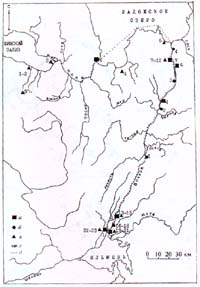
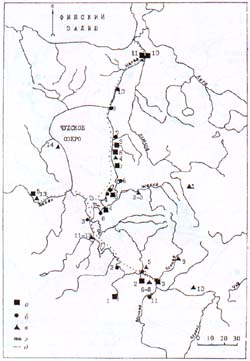
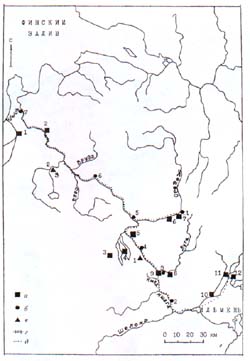

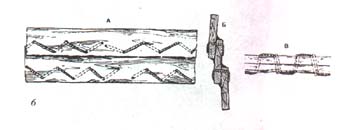
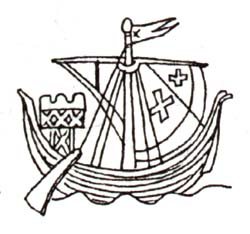
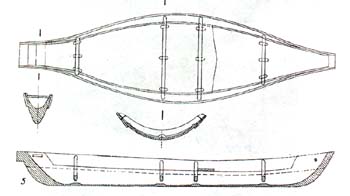
 Back to Nordic Underwater Archaeology
Back to Nordic Underwater Archaeology